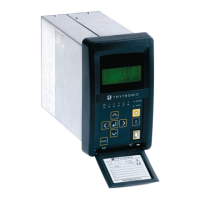MEASURES, LOGIC STATES AND COUNTERS
89
NA10 - Manual - 04 - 2022
Relays
For every output relay, the output operating state and diagnostic are available (Read \Relays menu):
• K1 State ON/OFF
• K1 Diagnostic OK/NOT OK
• K2 State ON/OFF
• K2 Diagnostic OK/NOT OK
• ......
• K6 State ON/OFF
• K6 Diagnostic OK/NOT OK
Counters
For every element two set of counters are available (Partial counters and Total counters); the partial
counters can be cleared by the user level, while the Total counter reset can be achieved with pass-
word (Session Level 1).
Every partial counter is reset to zero when ten thousand count is passed.
All partial counters can be cleared by means a single command; for this purpose the Reset partial
counters command must be issued (Commands \ Reset submenu).
• 50/51 - counter
• 50N/51N - counter
• 2ndh-REST - counter
• 74TCS - counter
• CB - counter
• 74CT - counter
• BF - counter
Partial counters
• xx Start partial counter (xx = I>, I>>,...) 0...9999
• xx Trip partial counter (xx = I>, I>>,...) 0...9999
• xx Block1 partial counter (xx = I>, I>>,...) 0...9999
• xx Block2 partial counter (xx = I>, I>>,...) 0...9999
Total counters
• xx Start total counter (xx = I>, I>>,...) 0...9999
• xx Trip total counter (xx = I>, I>>,...) 0...9999
• xx Block1 total counter (xx = I>, I>>,...) 0...9999
• xx Block2 total counter (xx = I>, I>>,...) 0...9999
Self test
Proper management (programming and remote monitoring) of the self-diagnosis function ensures
the fast detection of most of the protection system failures and significantly reduces the need for
periodic testing.
Following anomalies (MINOR) are not relevant (the protective elements continue to work):
• Oscillography run-time OK/NOT OK
• Data Bus minor OK/NOT OK
• Protection I/O assigned run-time minor OK/NOT OK
• PLC I/O not-matching run-time minor OK/NOT OK
Lower level diagnostic (MINOR) can be output or ignored; for this purpose the MINOR Fail alarm
parameter can be set ON or OFF inside the Set \ Self test relay submenu.
All remaining anomalies disables all protective functions
[1]
• Protection and controls ON SERVICE/OUT OF SERVICE
• System diagnostic OK/NOT OK
• Device diagnostic OK/NOT OK
• Program diagnostic OK/NOT OK
• Data-base boot OK/NOT OK
• Data-base runtime OK/NOT OK
• DSP boot OK/NOT OK
• DSP run-time OK/NOT OK
• Memory boot OK/NOT OK
• Memory run-time OK/NOT OK
• Data Bus heavy (failed ThyBus modules) OK/NOT OK
• PLC boot OK/NOT OK
• PLC run-time OK/NOT OK
• Protection I/O assigned verify startup OK/NOT OK
• Protection I/O assigned verify run-time major OK/NOT OK
• Total protection I/O assigned not-matching 0...
• Protection I/O assigned not-matching OK/NOT OK
• PLC I/O assigned verify startup OK/NOT OK
• PLC I/O assigned verify run-time major OK/NOT OK
• Total PLC I/O assigned not-matching 0...
• MMI module Boot OK/NOT OK
• MMI module Run-time OK/NOT OK
• MRI module Boot OK/NOT OK
• MRI module Run-time OK/NOT OK
• MID16-1 module Boot OK/NOT OK
• MID16-1 module Run-time OK/NOT OK
Note 1 The relays are being switched in rest position (ON if set with Energized logic - OFF if set with De-energized logic)

